Leadership and Management: Understanding the Differences and Similarities
VerifiedAdded on 2023/01/12
|15
|5095
|24
AI Summary
This report evaluates the difference between a leader and a manager, explores various theories and models used by leaders and managers, and discusses the importance of leadership development programs for organizational success.
Contribute Materials
Your contribution can guide someone’s learning journey. Share your
documents today.
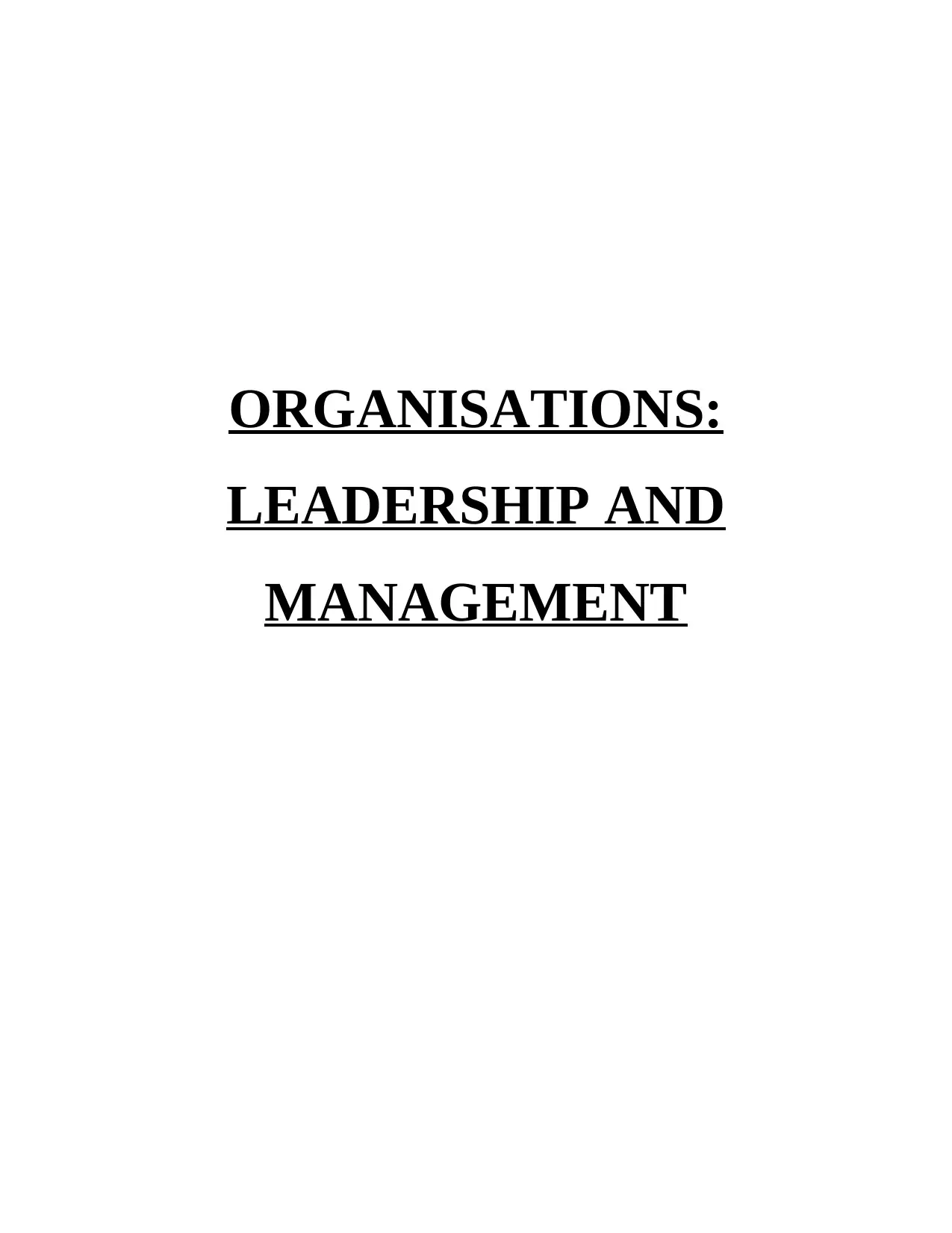
ORGANISATIONS:
LEADERSHIP AND
MANAGEMENT
LEADERSHIP AND
MANAGEMENT
Secure Best Marks with AI Grader
Need help grading? Try our AI Grader for instant feedback on your assignments.
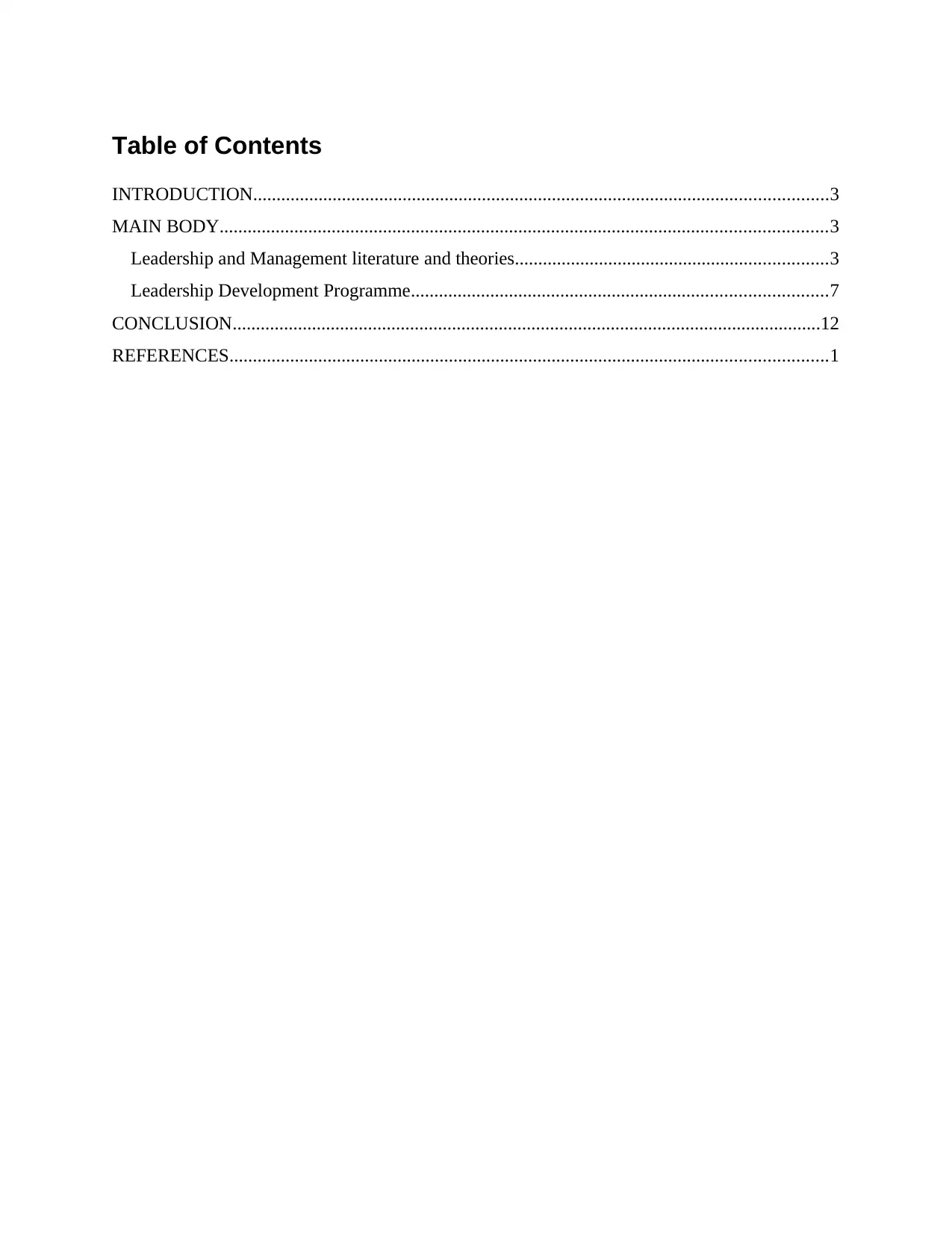
Table of Contents
INTRODUCTION...........................................................................................................................3
MAIN BODY..................................................................................................................................3
Leadership and Management literature and theories...................................................................3
Leadership Development Programme.........................................................................................7
CONCLUSION..............................................................................................................................12
REFERENCES................................................................................................................................1
INTRODUCTION...........................................................................................................................3
MAIN BODY..................................................................................................................................3
Leadership and Management literature and theories...................................................................3
Leadership Development Programme.........................................................................................7
CONCLUSION..............................................................................................................................12
REFERENCES................................................................................................................................1
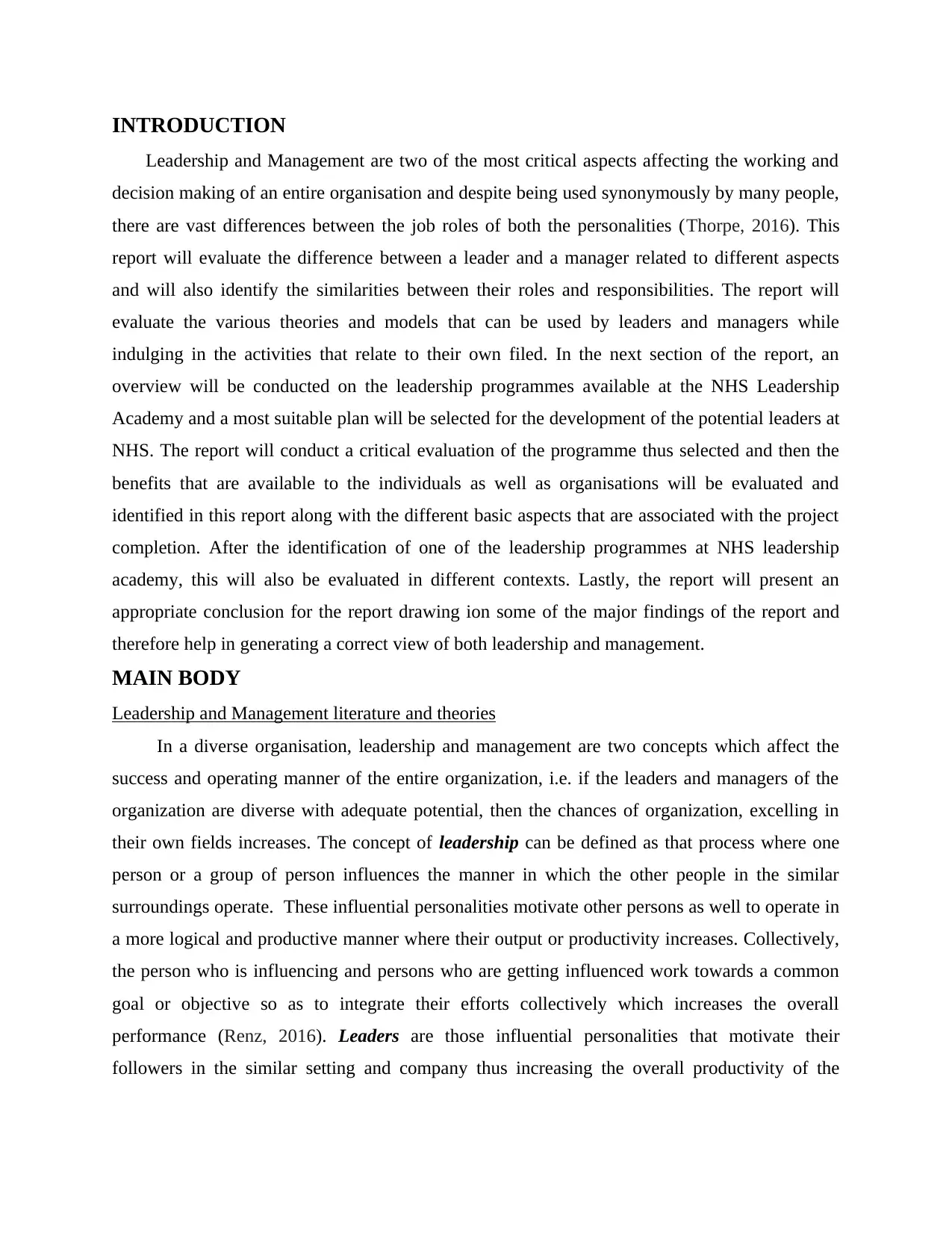
INTRODUCTION
Leadership and Management are two of the most critical aspects affecting the working and
decision making of an entire organisation and despite being used synonymously by many people,
there are vast differences between the job roles of both the personalities (Thorpe, 2016). This
report will evaluate the difference between a leader and a manager related to different aspects
and will also identify the similarities between their roles and responsibilities. The report will
evaluate the various theories and models that can be used by leaders and managers while
indulging in the activities that relate to their own filed. In the next section of the report, an
overview will be conducted on the leadership programmes available at the NHS Leadership
Academy and a most suitable plan will be selected for the development of the potential leaders at
NHS. The report will conduct a critical evaluation of the programme thus selected and then the
benefits that are available to the individuals as well as organisations will be evaluated and
identified in this report along with the different basic aspects that are associated with the project
completion. After the identification of one of the leadership programmes at NHS leadership
academy, this will also be evaluated in different contexts. Lastly, the report will present an
appropriate conclusion for the report drawing ion some of the major findings of the report and
therefore help in generating a correct view of both leadership and management.
MAIN BODY
Leadership and Management literature and theories
In a diverse organisation, leadership and management are two concepts which affect the
success and operating manner of the entire organization, i.e. if the leaders and managers of the
organization are diverse with adequate potential, then the chances of organization, excelling in
their own fields increases. The concept of leadership can be defined as that process where one
person or a group of person influences the manner in which the other people in the similar
surroundings operate. These influential personalities motivate other persons as well to operate in
a more logical and productive manner where their output or productivity increases. Collectively,
the person who is influencing and persons who are getting influenced work towards a common
goal or objective so as to integrate their efforts collectively which increases the overall
performance (Renz, 2016). Leaders are those influential personalities that motivate their
followers in the similar setting and company thus increasing the overall productivity of the
Leadership and Management are two of the most critical aspects affecting the working and
decision making of an entire organisation and despite being used synonymously by many people,
there are vast differences between the job roles of both the personalities (Thorpe, 2016). This
report will evaluate the difference between a leader and a manager related to different aspects
and will also identify the similarities between their roles and responsibilities. The report will
evaluate the various theories and models that can be used by leaders and managers while
indulging in the activities that relate to their own filed. In the next section of the report, an
overview will be conducted on the leadership programmes available at the NHS Leadership
Academy and a most suitable plan will be selected for the development of the potential leaders at
NHS. The report will conduct a critical evaluation of the programme thus selected and then the
benefits that are available to the individuals as well as organisations will be evaluated and
identified in this report along with the different basic aspects that are associated with the project
completion. After the identification of one of the leadership programmes at NHS leadership
academy, this will also be evaluated in different contexts. Lastly, the report will present an
appropriate conclusion for the report drawing ion some of the major findings of the report and
therefore help in generating a correct view of both leadership and management.
MAIN BODY
Leadership and Management literature and theories
In a diverse organisation, leadership and management are two concepts which affect the
success and operating manner of the entire organization, i.e. if the leaders and managers of the
organization are diverse with adequate potential, then the chances of organization, excelling in
their own fields increases. The concept of leadership can be defined as that process where one
person or a group of person influences the manner in which the other people in the similar
surroundings operate. These influential personalities motivate other persons as well to operate in
a more logical and productive manner where their output or productivity increases. Collectively,
the person who is influencing and persons who are getting influenced work towards a common
goal or objective so as to integrate their efforts collectively which increases the overall
performance (Renz, 2016). Leaders are those influential personalities that motivate their
followers in the similar setting and company thus increasing the overall productivity of the
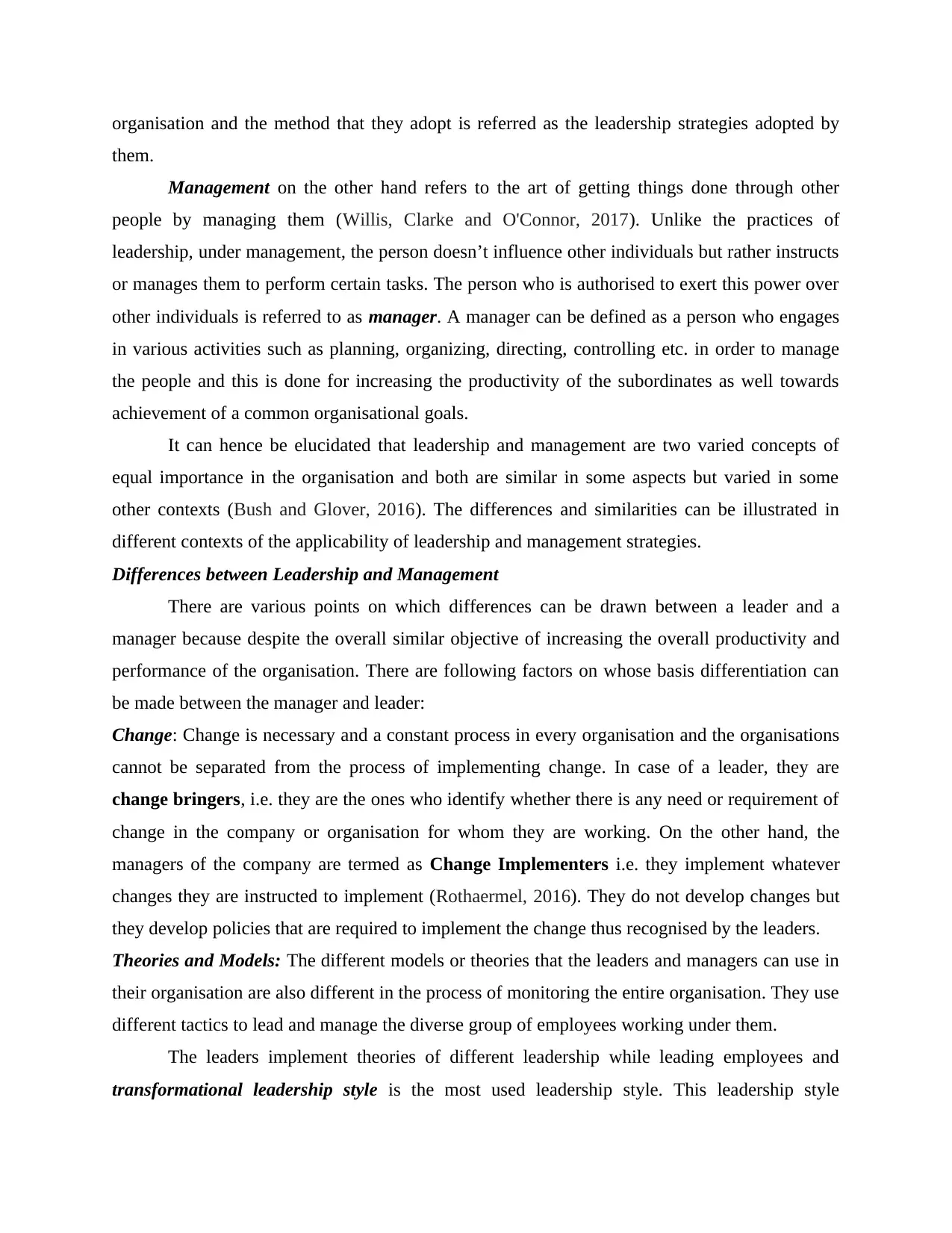
organisation and the method that they adopt is referred as the leadership strategies adopted by
them.
Management on the other hand refers to the art of getting things done through other
people by managing them (Willis, Clarke and O'Connor, 2017). Unlike the practices of
leadership, under management, the person doesn’t influence other individuals but rather instructs
or manages them to perform certain tasks. The person who is authorised to exert this power over
other individuals is referred to as manager. A manager can be defined as a person who engages
in various activities such as planning, organizing, directing, controlling etc. in order to manage
the people and this is done for increasing the productivity of the subordinates as well towards
achievement of a common organisational goals.
It can hence be elucidated that leadership and management are two varied concepts of
equal importance in the organisation and both are similar in some aspects but varied in some
other contexts (Bush and Glover, 2016). The differences and similarities can be illustrated in
different contexts of the applicability of leadership and management strategies.
Differences between Leadership and Management
There are various points on which differences can be drawn between a leader and a
manager because despite the overall similar objective of increasing the overall productivity and
performance of the organisation. There are following factors on whose basis differentiation can
be made between the manager and leader:
Change: Change is necessary and a constant process in every organisation and the organisations
cannot be separated from the process of implementing change. In case of a leader, they are
change bringers, i.e. they are the ones who identify whether there is any need or requirement of
change in the company or organisation for whom they are working. On the other hand, the
managers of the company are termed as Change Implementers i.e. they implement whatever
changes they are instructed to implement (Rothaermel, 2016). They do not develop changes but
they develop policies that are required to implement the change thus recognised by the leaders.
Theories and Models: The different models or theories that the leaders and managers can use in
their organisation are also different in the process of monitoring the entire organisation. They use
different tactics to lead and manage the diverse group of employees working under them.
The leaders implement theories of different leadership while leading employees and
transformational leadership style is the most used leadership style. This leadership style
them.
Management on the other hand refers to the art of getting things done through other
people by managing them (Willis, Clarke and O'Connor, 2017). Unlike the practices of
leadership, under management, the person doesn’t influence other individuals but rather instructs
or manages them to perform certain tasks. The person who is authorised to exert this power over
other individuals is referred to as manager. A manager can be defined as a person who engages
in various activities such as planning, organizing, directing, controlling etc. in order to manage
the people and this is done for increasing the productivity of the subordinates as well towards
achievement of a common organisational goals.
It can hence be elucidated that leadership and management are two varied concepts of
equal importance in the organisation and both are similar in some aspects but varied in some
other contexts (Bush and Glover, 2016). The differences and similarities can be illustrated in
different contexts of the applicability of leadership and management strategies.
Differences between Leadership and Management
There are various points on which differences can be drawn between a leader and a
manager because despite the overall similar objective of increasing the overall productivity and
performance of the organisation. There are following factors on whose basis differentiation can
be made between the manager and leader:
Change: Change is necessary and a constant process in every organisation and the organisations
cannot be separated from the process of implementing change. In case of a leader, they are
change bringers, i.e. they are the ones who identify whether there is any need or requirement of
change in the company or organisation for whom they are working. On the other hand, the
managers of the company are termed as Change Implementers i.e. they implement whatever
changes they are instructed to implement (Rothaermel, 2016). They do not develop changes but
they develop policies that are required to implement the change thus recognised by the leaders.
Theories and Models: The different models or theories that the leaders and managers can use in
their organisation are also different in the process of monitoring the entire organisation. They use
different tactics to lead and manage the diverse group of employees working under them.
The leaders implement theories of different leadership while leading employees and
transformational leadership style is the most used leadership style. This leadership style
Paraphrase This Document
Need a fresh take? Get an instant paraphrase of this document with our AI Paraphraser
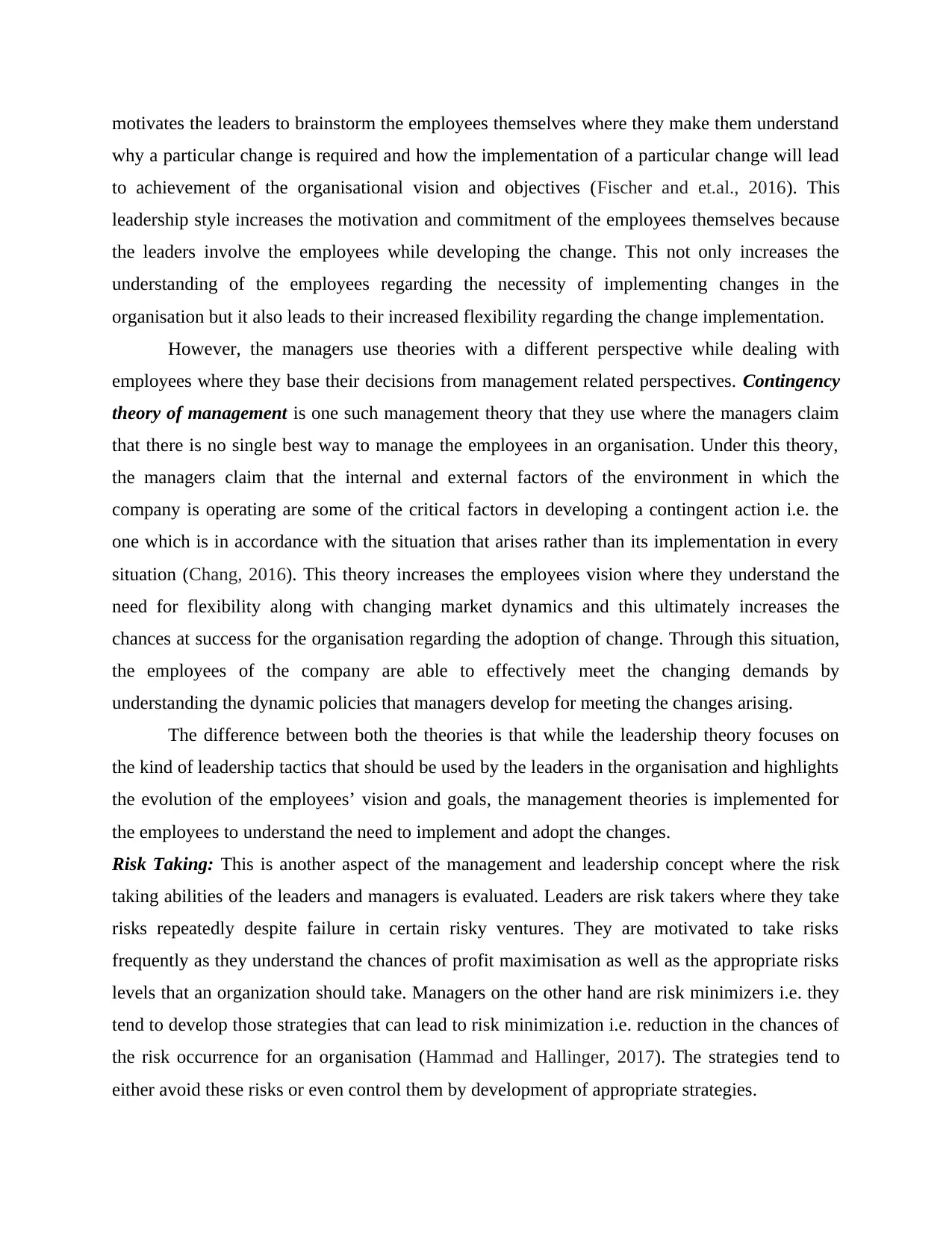
motivates the leaders to brainstorm the employees themselves where they make them understand
why a particular change is required and how the implementation of a particular change will lead
to achievement of the organisational vision and objectives (Fischer and et.al., 2016). This
leadership style increases the motivation and commitment of the employees themselves because
the leaders involve the employees while developing the change. This not only increases the
understanding of the employees regarding the necessity of implementing changes in the
organisation but it also leads to their increased flexibility regarding the change implementation.
However, the managers use theories with a different perspective while dealing with
employees where they base their decisions from management related perspectives. Contingency
theory of management is one such management theory that they use where the managers claim
that there is no single best way to manage the employees in an organisation. Under this theory,
the managers claim that the internal and external factors of the environment in which the
company is operating are some of the critical factors in developing a contingent action i.e. the
one which is in accordance with the situation that arises rather than its implementation in every
situation (Chang, 2016). This theory increases the employees vision where they understand the
need for flexibility along with changing market dynamics and this ultimately increases the
chances at success for the organisation regarding the adoption of change. Through this situation,
the employees of the company are able to effectively meet the changing demands by
understanding the dynamic policies that managers develop for meeting the changes arising.
The difference between both the theories is that while the leadership theory focuses on
the kind of leadership tactics that should be used by the leaders in the organisation and highlights
the evolution of the employees’ vision and goals, the management theories is implemented for
the employees to understand the need to implement and adopt the changes.
Risk Taking: This is another aspect of the management and leadership concept where the risk
taking abilities of the leaders and managers is evaluated. Leaders are risk takers where they take
risks repeatedly despite failure in certain risky ventures. They are motivated to take risks
frequently as they understand the chances of profit maximisation as well as the appropriate risks
levels that an organization should take. Managers on the other hand are risk minimizers i.e. they
tend to develop those strategies that can lead to risk minimization i.e. reduction in the chances of
the risk occurrence for an organisation (Hammad and Hallinger, 2017). The strategies tend to
either avoid these risks or even control them by development of appropriate strategies.
why a particular change is required and how the implementation of a particular change will lead
to achievement of the organisational vision and objectives (Fischer and et.al., 2016). This
leadership style increases the motivation and commitment of the employees themselves because
the leaders involve the employees while developing the change. This not only increases the
understanding of the employees regarding the necessity of implementing changes in the
organisation but it also leads to their increased flexibility regarding the change implementation.
However, the managers use theories with a different perspective while dealing with
employees where they base their decisions from management related perspectives. Contingency
theory of management is one such management theory that they use where the managers claim
that there is no single best way to manage the employees in an organisation. Under this theory,
the managers claim that the internal and external factors of the environment in which the
company is operating are some of the critical factors in developing a contingent action i.e. the
one which is in accordance with the situation that arises rather than its implementation in every
situation (Chang, 2016). This theory increases the employees vision where they understand the
need for flexibility along with changing market dynamics and this ultimately increases the
chances at success for the organisation regarding the adoption of change. Through this situation,
the employees of the company are able to effectively meet the changing demands by
understanding the dynamic policies that managers develop for meeting the changes arising.
The difference between both the theories is that while the leadership theory focuses on
the kind of leadership tactics that should be used by the leaders in the organisation and highlights
the evolution of the employees’ vision and goals, the management theories is implemented for
the employees to understand the need to implement and adopt the changes.
Risk Taking: This is another aspect of the management and leadership concept where the risk
taking abilities of the leaders and managers is evaluated. Leaders are risk takers where they take
risks repeatedly despite failure in certain risky ventures. They are motivated to take risks
frequently as they understand the chances of profit maximisation as well as the appropriate risks
levels that an organization should take. Managers on the other hand are risk minimizers i.e. they
tend to develop those strategies that can lead to risk minimization i.e. reduction in the chances of
the risk occurrence for an organisation (Hammad and Hallinger, 2017). The strategies tend to
either avoid these risks or even control them by development of appropriate strategies.
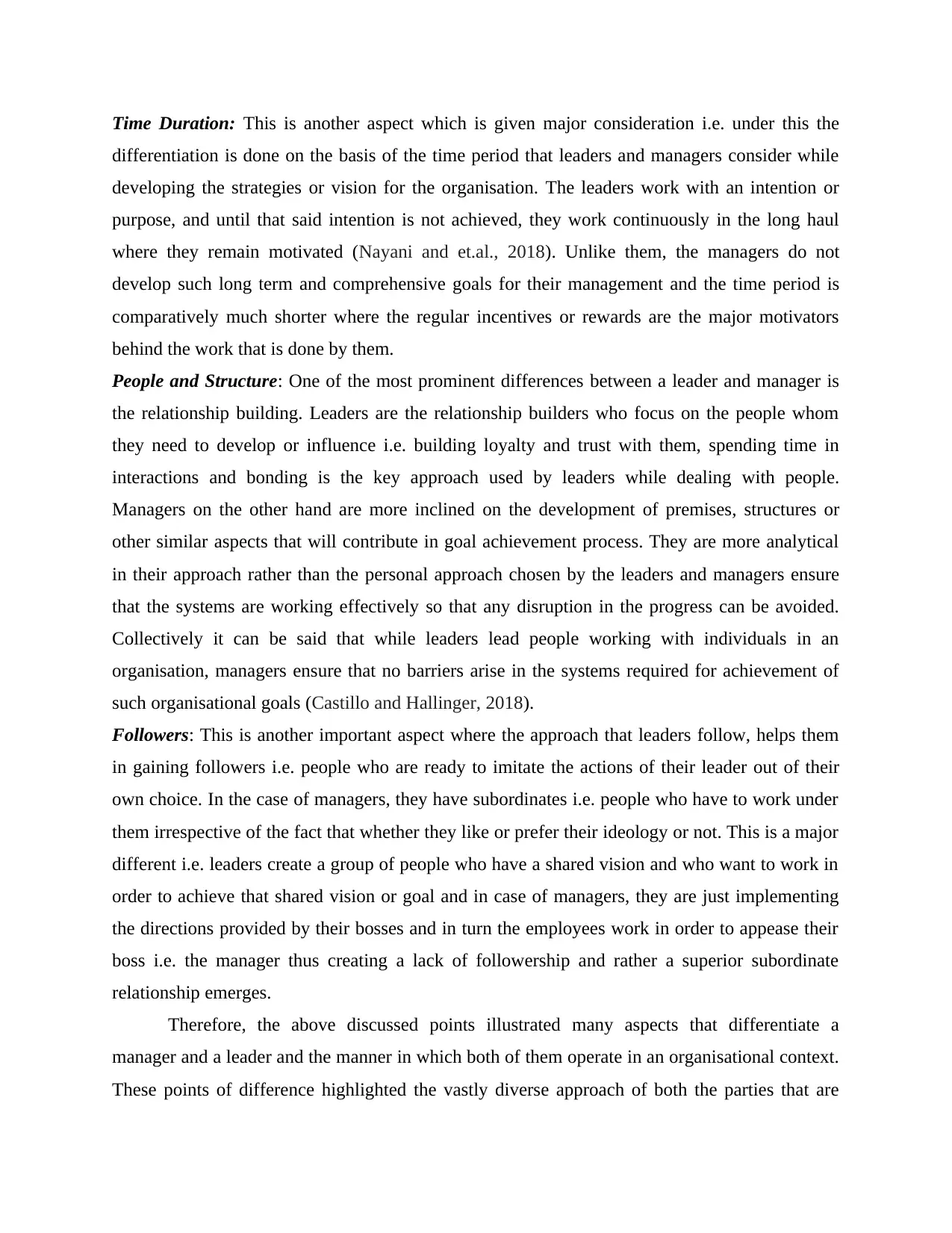
Time Duration: This is another aspect which is given major consideration i.e. under this the
differentiation is done on the basis of the time period that leaders and managers consider while
developing the strategies or vision for the organisation. The leaders work with an intention or
purpose, and until that said intention is not achieved, they work continuously in the long haul
where they remain motivated (Nayani and et.al., 2018). Unlike them, the managers do not
develop such long term and comprehensive goals for their management and the time period is
comparatively much shorter where the regular incentives or rewards are the major motivators
behind the work that is done by them.
People and Structure: One of the most prominent differences between a leader and manager is
the relationship building. Leaders are the relationship builders who focus on the people whom
they need to develop or influence i.e. building loyalty and trust with them, spending time in
interactions and bonding is the key approach used by leaders while dealing with people.
Managers on the other hand are more inclined on the development of premises, structures or
other similar aspects that will contribute in goal achievement process. They are more analytical
in their approach rather than the personal approach chosen by the leaders and managers ensure
that the systems are working effectively so that any disruption in the progress can be avoided.
Collectively it can be said that while leaders lead people working with individuals in an
organisation, managers ensure that no barriers arise in the systems required for achievement of
such organisational goals (Castillo and Hallinger, 2018).
Followers: This is another important aspect where the approach that leaders follow, helps them
in gaining followers i.e. people who are ready to imitate the actions of their leader out of their
own choice. In the case of managers, they have subordinates i.e. people who have to work under
them irrespective of the fact that whether they like or prefer their ideology or not. This is a major
different i.e. leaders create a group of people who have a shared vision and who want to work in
order to achieve that shared vision or goal and in case of managers, they are just implementing
the directions provided by their bosses and in turn the employees work in order to appease their
boss i.e. the manager thus creating a lack of followership and rather a superior subordinate
relationship emerges.
Therefore, the above discussed points illustrated many aspects that differentiate a
manager and a leader and the manner in which both of them operate in an organisational context.
These points of difference highlighted the vastly diverse approach of both the parties that are
differentiation is done on the basis of the time period that leaders and managers consider while
developing the strategies or vision for the organisation. The leaders work with an intention or
purpose, and until that said intention is not achieved, they work continuously in the long haul
where they remain motivated (Nayani and et.al., 2018). Unlike them, the managers do not
develop such long term and comprehensive goals for their management and the time period is
comparatively much shorter where the regular incentives or rewards are the major motivators
behind the work that is done by them.
People and Structure: One of the most prominent differences between a leader and manager is
the relationship building. Leaders are the relationship builders who focus on the people whom
they need to develop or influence i.e. building loyalty and trust with them, spending time in
interactions and bonding is the key approach used by leaders while dealing with people.
Managers on the other hand are more inclined on the development of premises, structures or
other similar aspects that will contribute in goal achievement process. They are more analytical
in their approach rather than the personal approach chosen by the leaders and managers ensure
that the systems are working effectively so that any disruption in the progress can be avoided.
Collectively it can be said that while leaders lead people working with individuals in an
organisation, managers ensure that no barriers arise in the systems required for achievement of
such organisational goals (Castillo and Hallinger, 2018).
Followers: This is another important aspect where the approach that leaders follow, helps them
in gaining followers i.e. people who are ready to imitate the actions of their leader out of their
own choice. In the case of managers, they have subordinates i.e. people who have to work under
them irrespective of the fact that whether they like or prefer their ideology or not. This is a major
different i.e. leaders create a group of people who have a shared vision and who want to work in
order to achieve that shared vision or goal and in case of managers, they are just implementing
the directions provided by their bosses and in turn the employees work in order to appease their
boss i.e. the manager thus creating a lack of followership and rather a superior subordinate
relationship emerges.
Therefore, the above discussed points illustrated many aspects that differentiate a
manager and a leader and the manner in which both of them operate in an organisational context.
These points of difference highlighted the vastly diverse approach of both the parties that are
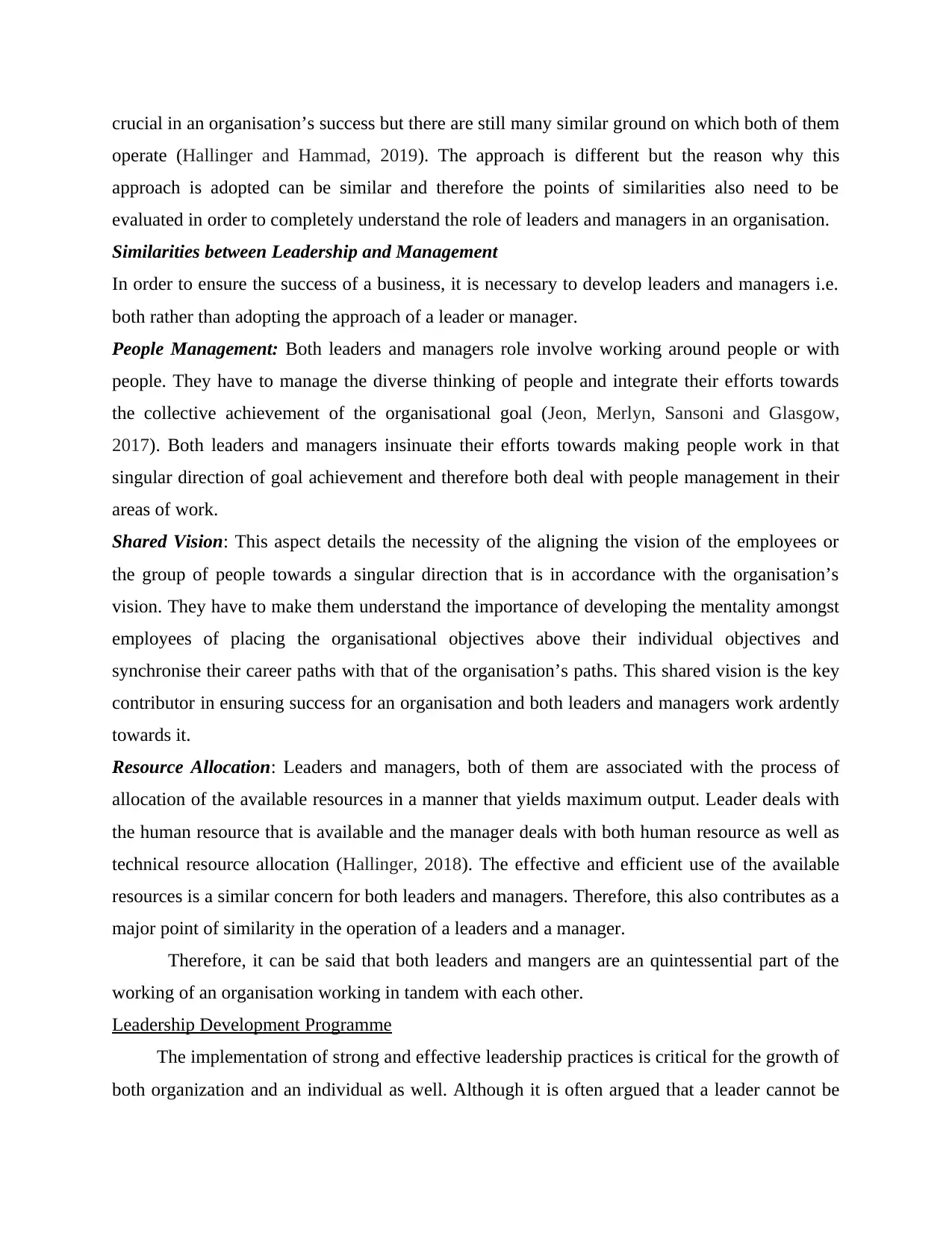
crucial in an organisation’s success but there are still many similar ground on which both of them
operate (Hallinger and Hammad, 2019). The approach is different but the reason why this
approach is adopted can be similar and therefore the points of similarities also need to be
evaluated in order to completely understand the role of leaders and managers in an organisation.
Similarities between Leadership and Management
In order to ensure the success of a business, it is necessary to develop leaders and managers i.e.
both rather than adopting the approach of a leader or manager.
People Management: Both leaders and managers role involve working around people or with
people. They have to manage the diverse thinking of people and integrate their efforts towards
the collective achievement of the organisational goal (Jeon, Merlyn, Sansoni and Glasgow,
2017). Both leaders and managers insinuate their efforts towards making people work in that
singular direction of goal achievement and therefore both deal with people management in their
areas of work.
Shared Vision: This aspect details the necessity of the aligning the vision of the employees or
the group of people towards a singular direction that is in accordance with the organisation’s
vision. They have to make them understand the importance of developing the mentality amongst
employees of placing the organisational objectives above their individual objectives and
synchronise their career paths with that of the organisation’s paths. This shared vision is the key
contributor in ensuring success for an organisation and both leaders and managers work ardently
towards it.
Resource Allocation: Leaders and managers, both of them are associated with the process of
allocation of the available resources in a manner that yields maximum output. Leader deals with
the human resource that is available and the manager deals with both human resource as well as
technical resource allocation (Hallinger, 2018). The effective and efficient use of the available
resources is a similar concern for both leaders and managers. Therefore, this also contributes as a
major point of similarity in the operation of a leaders and a manager.
Therefore, it can be said that both leaders and mangers are an quintessential part of the
working of an organisation working in tandem with each other.
Leadership Development Programme
The implementation of strong and effective leadership practices is critical for the growth of
both organization and an individual as well. Although it is often argued that a leader cannot be
operate (Hallinger and Hammad, 2019). The approach is different but the reason why this
approach is adopted can be similar and therefore the points of similarities also need to be
evaluated in order to completely understand the role of leaders and managers in an organisation.
Similarities between Leadership and Management
In order to ensure the success of a business, it is necessary to develop leaders and managers i.e.
both rather than adopting the approach of a leader or manager.
People Management: Both leaders and managers role involve working around people or with
people. They have to manage the diverse thinking of people and integrate their efforts towards
the collective achievement of the organisational goal (Jeon, Merlyn, Sansoni and Glasgow,
2017). Both leaders and managers insinuate their efforts towards making people work in that
singular direction of goal achievement and therefore both deal with people management in their
areas of work.
Shared Vision: This aspect details the necessity of the aligning the vision of the employees or
the group of people towards a singular direction that is in accordance with the organisation’s
vision. They have to make them understand the importance of developing the mentality amongst
employees of placing the organisational objectives above their individual objectives and
synchronise their career paths with that of the organisation’s paths. This shared vision is the key
contributor in ensuring success for an organisation and both leaders and managers work ardently
towards it.
Resource Allocation: Leaders and managers, both of them are associated with the process of
allocation of the available resources in a manner that yields maximum output. Leader deals with
the human resource that is available and the manager deals with both human resource as well as
technical resource allocation (Hallinger, 2018). The effective and efficient use of the available
resources is a similar concern for both leaders and managers. Therefore, this also contributes as a
major point of similarity in the operation of a leaders and a manager.
Therefore, it can be said that both leaders and mangers are an quintessential part of the
working of an organisation working in tandem with each other.
Leadership Development Programme
The implementation of strong and effective leadership practices is critical for the growth of
both organization and an individual as well. Although it is often argued that a leader cannot be
Secure Best Marks with AI Grader
Need help grading? Try our AI Grader for instant feedback on your assignments.
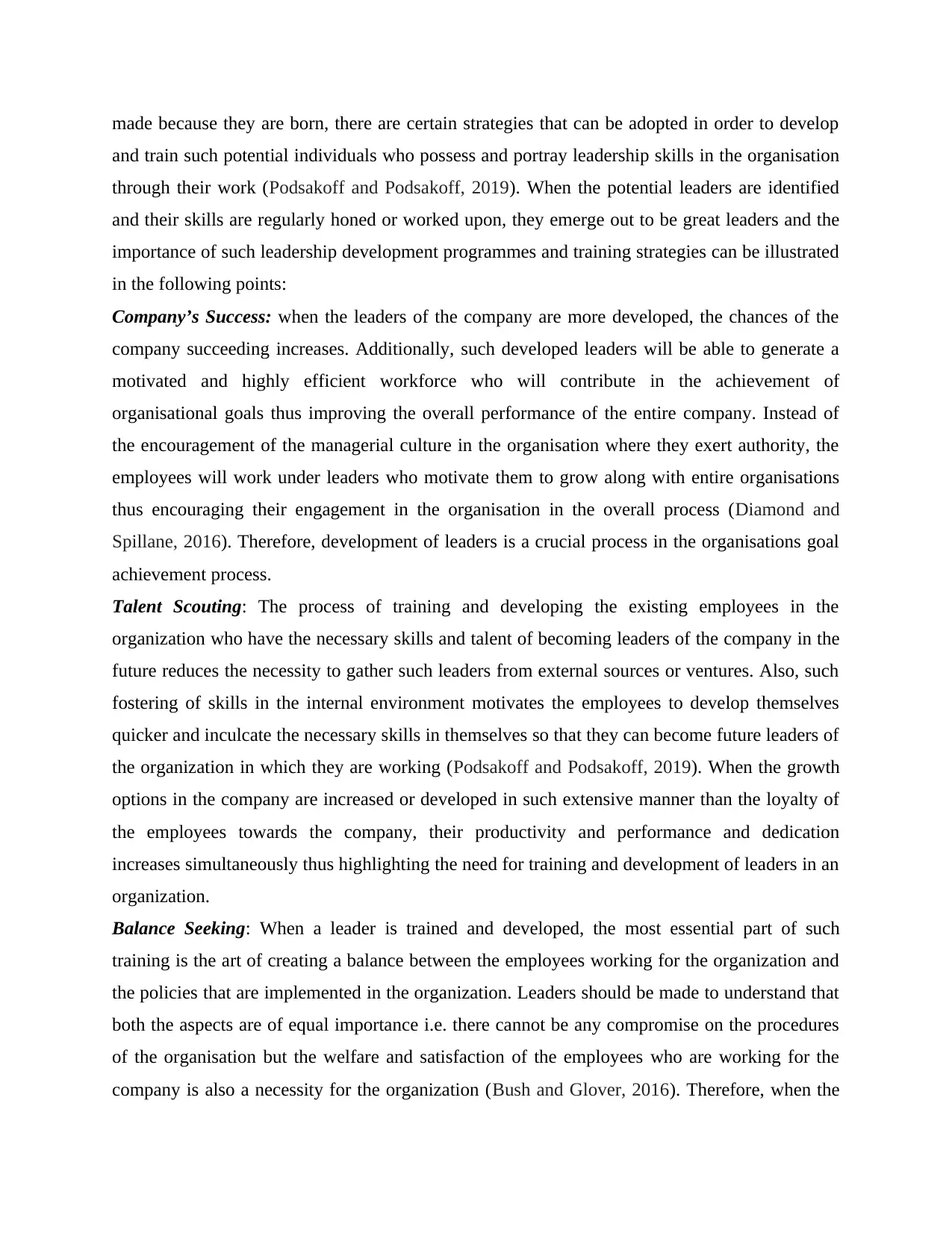
made because they are born, there are certain strategies that can be adopted in order to develop
and train such potential individuals who possess and portray leadership skills in the organisation
through their work (Podsakoff and Podsakoff, 2019). When the potential leaders are identified
and their skills are regularly honed or worked upon, they emerge out to be great leaders and the
importance of such leadership development programmes and training strategies can be illustrated
in the following points:
Company’s Success: when the leaders of the company are more developed, the chances of the
company succeeding increases. Additionally, such developed leaders will be able to generate a
motivated and highly efficient workforce who will contribute in the achievement of
organisational goals thus improving the overall performance of the entire company. Instead of
the encouragement of the managerial culture in the organisation where they exert authority, the
employees will work under leaders who motivate them to grow along with entire organisations
thus encouraging their engagement in the organisation in the overall process (Diamond and
Spillane, 2016). Therefore, development of leaders is a crucial process in the organisations goal
achievement process.
Talent Scouting: The process of training and developing the existing employees in the
organization who have the necessary skills and talent of becoming leaders of the company in the
future reduces the necessity to gather such leaders from external sources or ventures. Also, such
fostering of skills in the internal environment motivates the employees to develop themselves
quicker and inculcate the necessary skills in themselves so that they can become future leaders of
the organization in which they are working (Podsakoff and Podsakoff, 2019). When the growth
options in the company are increased or developed in such extensive manner than the loyalty of
the employees towards the company, their productivity and performance and dedication
increases simultaneously thus highlighting the need for training and development of leaders in an
organization.
Balance Seeking: When a leader is trained and developed, the most essential part of such
training is the art of creating a balance between the employees working for the organization and
the policies that are implemented in the organization. Leaders should be made to understand that
both the aspects are of equal importance i.e. there cannot be any compromise on the procedures
of the organisation but the welfare and satisfaction of the employees who are working for the
company is also a necessity for the organization (Bush and Glover, 2016). Therefore, when the
and train such potential individuals who possess and portray leadership skills in the organisation
through their work (Podsakoff and Podsakoff, 2019). When the potential leaders are identified
and their skills are regularly honed or worked upon, they emerge out to be great leaders and the
importance of such leadership development programmes and training strategies can be illustrated
in the following points:
Company’s Success: when the leaders of the company are more developed, the chances of the
company succeeding increases. Additionally, such developed leaders will be able to generate a
motivated and highly efficient workforce who will contribute in the achievement of
organisational goals thus improving the overall performance of the entire company. Instead of
the encouragement of the managerial culture in the organisation where they exert authority, the
employees will work under leaders who motivate them to grow along with entire organisations
thus encouraging their engagement in the organisation in the overall process (Diamond and
Spillane, 2016). Therefore, development of leaders is a crucial process in the organisations goal
achievement process.
Talent Scouting: The process of training and developing the existing employees in the
organization who have the necessary skills and talent of becoming leaders of the company in the
future reduces the necessity to gather such leaders from external sources or ventures. Also, such
fostering of skills in the internal environment motivates the employees to develop themselves
quicker and inculcate the necessary skills in themselves so that they can become future leaders of
the organization in which they are working (Podsakoff and Podsakoff, 2019). When the growth
options in the company are increased or developed in such extensive manner than the loyalty of
the employees towards the company, their productivity and performance and dedication
increases simultaneously thus highlighting the need for training and development of leaders in an
organization.
Balance Seeking: When a leader is trained and developed, the most essential part of such
training is the art of creating a balance between the employees working for the organization and
the policies that are implemented in the organization. Leaders should be made to understand that
both the aspects are of equal importance i.e. there cannot be any compromise on the procedures
of the organisation but the welfare and satisfaction of the employees who are working for the
company is also a necessity for the organization (Bush and Glover, 2016). Therefore, when the
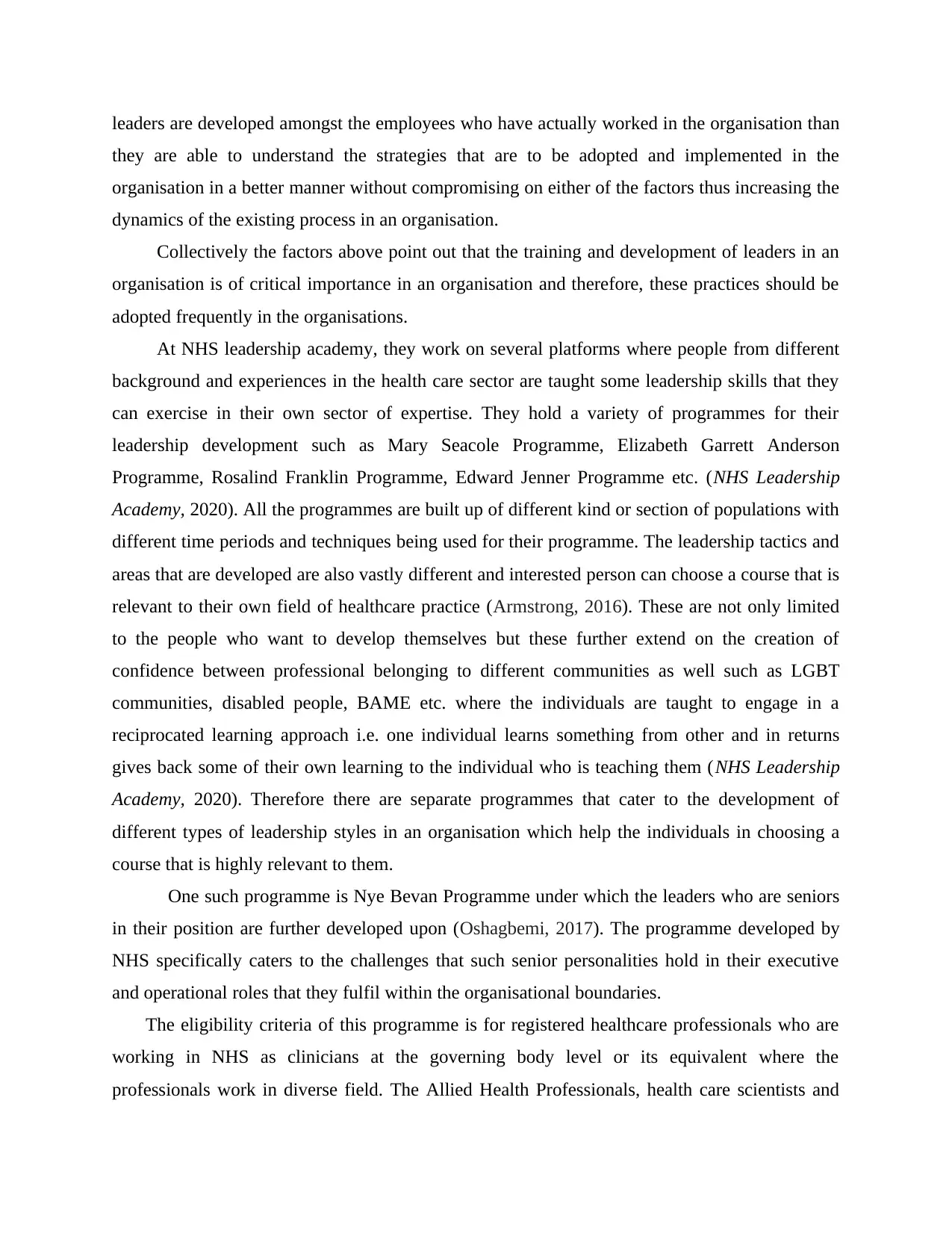
leaders are developed amongst the employees who have actually worked in the organisation than
they are able to understand the strategies that are to be adopted and implemented in the
organisation in a better manner without compromising on either of the factors thus increasing the
dynamics of the existing process in an organisation.
Collectively the factors above point out that the training and development of leaders in an
organisation is of critical importance in an organisation and therefore, these practices should be
adopted frequently in the organisations.
At NHS leadership academy, they work on several platforms where people from different
background and experiences in the health care sector are taught some leadership skills that they
can exercise in their own sector of expertise. They hold a variety of programmes for their
leadership development such as Mary Seacole Programme, Elizabeth Garrett Anderson
Programme, Rosalind Franklin Programme, Edward Jenner Programme etc. (NHS Leadership
Academy, 2020). All the programmes are built up of different kind or section of populations with
different time periods and techniques being used for their programme. The leadership tactics and
areas that are developed are also vastly different and interested person can choose a course that is
relevant to their own field of healthcare practice (Armstrong, 2016). These are not only limited
to the people who want to develop themselves but these further extend on the creation of
confidence between professional belonging to different communities as well such as LGBT
communities, disabled people, BAME etc. where the individuals are taught to engage in a
reciprocated learning approach i.e. one individual learns something from other and in returns
gives back some of their own learning to the individual who is teaching them (NHS Leadership
Academy, 2020). Therefore there are separate programmes that cater to the development of
different types of leadership styles in an organisation which help the individuals in choosing a
course that is highly relevant to them.
One such programme is Nye Bevan Programme under which the leaders who are seniors
in their position are further developed upon (Oshagbemi, 2017). The programme developed by
NHS specifically caters to the challenges that such senior personalities hold in their executive
and operational roles that they fulfil within the organisational boundaries.
The eligibility criteria of this programme is for registered healthcare professionals who are
working in NHS as clinicians at the governing body level or its equivalent where the
professionals work in diverse field. The Allied Health Professionals, health care scientists and
they are able to understand the strategies that are to be adopted and implemented in the
organisation in a better manner without compromising on either of the factors thus increasing the
dynamics of the existing process in an organisation.
Collectively the factors above point out that the training and development of leaders in an
organisation is of critical importance in an organisation and therefore, these practices should be
adopted frequently in the organisations.
At NHS leadership academy, they work on several platforms where people from different
background and experiences in the health care sector are taught some leadership skills that they
can exercise in their own sector of expertise. They hold a variety of programmes for their
leadership development such as Mary Seacole Programme, Elizabeth Garrett Anderson
Programme, Rosalind Franklin Programme, Edward Jenner Programme etc. (NHS Leadership
Academy, 2020). All the programmes are built up of different kind or section of populations with
different time periods and techniques being used for their programme. The leadership tactics and
areas that are developed are also vastly different and interested person can choose a course that is
relevant to their own field of healthcare practice (Armstrong, 2016). These are not only limited
to the people who want to develop themselves but these further extend on the creation of
confidence between professional belonging to different communities as well such as LGBT
communities, disabled people, BAME etc. where the individuals are taught to engage in a
reciprocated learning approach i.e. one individual learns something from other and in returns
gives back some of their own learning to the individual who is teaching them (NHS Leadership
Academy, 2020). Therefore there are separate programmes that cater to the development of
different types of leadership styles in an organisation which help the individuals in choosing a
course that is highly relevant to them.
One such programme is Nye Bevan Programme under which the leaders who are seniors
in their position are further developed upon (Oshagbemi, 2017). The programme developed by
NHS specifically caters to the challenges that such senior personalities hold in their executive
and operational roles that they fulfil within the organisational boundaries.
The eligibility criteria of this programme is for registered healthcare professionals who are
working in NHS as clinicians at the governing body level or its equivalent where the
professionals work in diverse field. The Allied Health Professionals, health care scientists and

the clinical pharmacists are the eligible participants for this programme who are already working
at a governing position in their own departments and can further expand the skills that they
possess (Rothaermel, 2016). Additionally, the employees of department of Health and Social
Care are also eligible for the enrolment in their leadership programmes through national health
and care arm’s length bodies.
Basically, under this programmes the professional leaders are made to learn the skills that
are required for the corporate executive leadership and these specifically addresses the
challenges that arise while exercising such challenging roles. The structure of the leadership
flows from the Initial Diagnostics to Know Yourself and Others to Broadening Horizons to the
fourth stage of Making the case for change and lastly a Viva is taken (Gopee and Galloway,
2017). At every stages the practical challenges that arises are highlighted before the candidates
where they are conditioned to increase their awareness of the skills and the external environment
that are required to be compensates through the different roles and responsibilities that are
required to be complied with. There are several benefits of the programmes for the individuals
enrolled in the programme as well as the entire organisation whose employees are enrolling in
these programmes.
Initial Diagnostics involves the pre- diagnostic work procedures that are just basic
paperwork and other related details. In second stage of Knowing Yourself and others, the
methods of online case studies and other work- based studies are carried out by the enrolled
individuals. A residential workshop is conducted then for a period of 4 days approximately
where their skills are tested through practical application. Also, the learning set meeting is
conducted at Stage 1 in the third day i.e. the day 3 of the residential workshop that is held for the
individuals. The third stage is the Broadening Horizons stage and in this again online tests as
well as work based studies are carried out along with a complete residential workshop for 3 days
again (Willis, Clarke and O'Connor, 2017). However, between second and third stage of
Knowing Yourself and others and Broadening Horizons, there is the second learning meeting
that is organized which is done after the initial period of six weeks and before completion of
eight weeks at the maximum. Then there is the fourth stage of Making the case for change
where again real life cases are discussed and the residential workshops are conducted and
similarly in the last stage as well where Viva is conducted a two days’ residential workshop is
held as well. The learning set meetings are conducted frequently along with the designated
at a governing position in their own departments and can further expand the skills that they
possess (Rothaermel, 2016). Additionally, the employees of department of Health and Social
Care are also eligible for the enrolment in their leadership programmes through national health
and care arm’s length bodies.
Basically, under this programmes the professional leaders are made to learn the skills that
are required for the corporate executive leadership and these specifically addresses the
challenges that arise while exercising such challenging roles. The structure of the leadership
flows from the Initial Diagnostics to Know Yourself and Others to Broadening Horizons to the
fourth stage of Making the case for change and lastly a Viva is taken (Gopee and Galloway,
2017). At every stages the practical challenges that arises are highlighted before the candidates
where they are conditioned to increase their awareness of the skills and the external environment
that are required to be compensates through the different roles and responsibilities that are
required to be complied with. There are several benefits of the programmes for the individuals
enrolled in the programme as well as the entire organisation whose employees are enrolling in
these programmes.
Initial Diagnostics involves the pre- diagnostic work procedures that are just basic
paperwork and other related details. In second stage of Knowing Yourself and others, the
methods of online case studies and other work- based studies are carried out by the enrolled
individuals. A residential workshop is conducted then for a period of 4 days approximately
where their skills are tested through practical application. Also, the learning set meeting is
conducted at Stage 1 in the third day i.e. the day 3 of the residential workshop that is held for the
individuals. The third stage is the Broadening Horizons stage and in this again online tests as
well as work based studies are carried out along with a complete residential workshop for 3 days
again (Willis, Clarke and O'Connor, 2017). However, between second and third stage of
Knowing Yourself and others and Broadening Horizons, there is the second learning meeting
that is organized which is done after the initial period of six weeks and before completion of
eight weeks at the maximum. Then there is the fourth stage of Making the case for change
where again real life cases are discussed and the residential workshops are conducted and
similarly in the last stage as well where Viva is conducted a two days’ residential workshop is
held as well. The learning set meetings are conducted frequently along with the designated
Paraphrase This Document
Need a fresh take? Get an instant paraphrase of this document with our AI Paraphraser
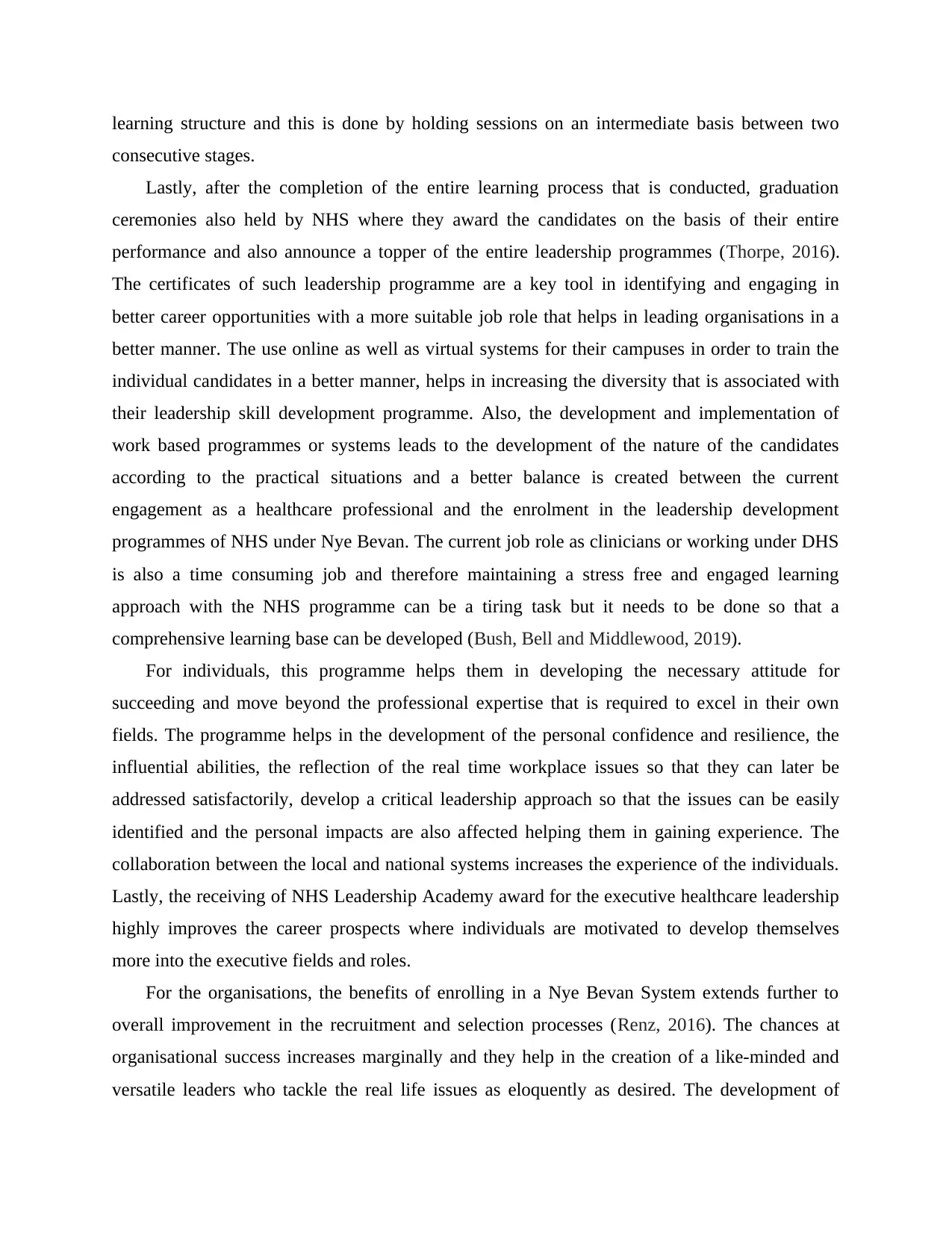
learning structure and this is done by holding sessions on an intermediate basis between two
consecutive stages.
Lastly, after the completion of the entire learning process that is conducted, graduation
ceremonies also held by NHS where they award the candidates on the basis of their entire
performance and also announce a topper of the entire leadership programmes (Thorpe, 2016).
The certificates of such leadership programme are a key tool in identifying and engaging in
better career opportunities with a more suitable job role that helps in leading organisations in a
better manner. The use online as well as virtual systems for their campuses in order to train the
individual candidates in a better manner, helps in increasing the diversity that is associated with
their leadership skill development programme. Also, the development and implementation of
work based programmes or systems leads to the development of the nature of the candidates
according to the practical situations and a better balance is created between the current
engagement as a healthcare professional and the enrolment in the leadership development
programmes of NHS under Nye Bevan. The current job role as clinicians or working under DHS
is also a time consuming job and therefore maintaining a stress free and engaged learning
approach with the NHS programme can be a tiring task but it needs to be done so that a
comprehensive learning base can be developed (Bush, Bell and Middlewood, 2019).
For individuals, this programme helps them in developing the necessary attitude for
succeeding and move beyond the professional expertise that is required to excel in their own
fields. The programme helps in the development of the personal confidence and resilience, the
influential abilities, the reflection of the real time workplace issues so that they can later be
addressed satisfactorily, develop a critical leadership approach so that the issues can be easily
identified and the personal impacts are also affected helping them in gaining experience. The
collaboration between the local and national systems increases the experience of the individuals.
Lastly, the receiving of NHS Leadership Academy award for the executive healthcare leadership
highly improves the career prospects where individuals are motivated to develop themselves
more into the executive fields and roles.
For the organisations, the benefits of enrolling in a Nye Bevan System extends further to
overall improvement in the recruitment and selection processes (Renz, 2016). The chances at
organisational success increases marginally and they help in the creation of a like-minded and
versatile leaders who tackle the real life issues as eloquently as desired. The development of
consecutive stages.
Lastly, after the completion of the entire learning process that is conducted, graduation
ceremonies also held by NHS where they award the candidates on the basis of their entire
performance and also announce a topper of the entire leadership programmes (Thorpe, 2016).
The certificates of such leadership programme are a key tool in identifying and engaging in
better career opportunities with a more suitable job role that helps in leading organisations in a
better manner. The use online as well as virtual systems for their campuses in order to train the
individual candidates in a better manner, helps in increasing the diversity that is associated with
their leadership skill development programme. Also, the development and implementation of
work based programmes or systems leads to the development of the nature of the candidates
according to the practical situations and a better balance is created between the current
engagement as a healthcare professional and the enrolment in the leadership development
programmes of NHS under Nye Bevan. The current job role as clinicians or working under DHS
is also a time consuming job and therefore maintaining a stress free and engaged learning
approach with the NHS programme can be a tiring task but it needs to be done so that a
comprehensive learning base can be developed (Bush, Bell and Middlewood, 2019).
For individuals, this programme helps them in developing the necessary attitude for
succeeding and move beyond the professional expertise that is required to excel in their own
fields. The programme helps in the development of the personal confidence and resilience, the
influential abilities, the reflection of the real time workplace issues so that they can later be
addressed satisfactorily, develop a critical leadership approach so that the issues can be easily
identified and the personal impacts are also affected helping them in gaining experience. The
collaboration between the local and national systems increases the experience of the individuals.
Lastly, the receiving of NHS Leadership Academy award for the executive healthcare leadership
highly improves the career prospects where individuals are motivated to develop themselves
more into the executive fields and roles.
For the organisations, the benefits of enrolling in a Nye Bevan System extends further to
overall improvement in the recruitment and selection processes (Renz, 2016). The chances at
organisational success increases marginally and they help in the creation of a like-minded and
versatile leaders who tackle the real life issues as eloquently as desired. The development of

innovation and resilience in the individuals help in improving the quality of services that are
provided to the patients that are being treated. For the organisation as a whole this method or
leadership programmes helps in the development of a pipeline of clinical as well as non- clinical
talent necessary for the organisation.
CONCLUSION
The research conducted in the report above helps in concluding that the concept of
leadership and manager are two of the most different and yet similar aspects in an organizations
culture and success. The report identified the concept of both leadership and management and
then identifies those points on which the differences can be drawn on them by using theories
such as transformational leadership theory and contingency management theory, risk taking
abilities etc. but the report also concluded some points of similarities such as shared
organizational vision etc. the report concluded that the leadership and management both work
hand in hand and one aspect cannot be declared as superior or more important over another. The
report also evaluated the Nye Bevan Leadership programme at the NHS Leadership academy
where the development of professional leadership into the corporate leadership was highlighted
and discussed. Collectively, a critical evaluation was conducted on the entire programme that
was available and this led to the conclusion that Leadership academy programmes under NHS
were varied for developing different kinds of dynamic leader and this was extremely important in
analysing the importance of integrating leadership skills in individuals at all levels and scales.
Lastly, in this report, the entire structure of the Nye Bevan programme was discussed along with
the different benefits that are inherent in the programme both for an individual who is enrolled
and the organisation for which that person works. This concludes that leadership and
management in all contexts is necessary for the operation of the organization.
provided to the patients that are being treated. For the organisation as a whole this method or
leadership programmes helps in the development of a pipeline of clinical as well as non- clinical
talent necessary for the organisation.
CONCLUSION
The research conducted in the report above helps in concluding that the concept of
leadership and manager are two of the most different and yet similar aspects in an organizations
culture and success. The report identified the concept of both leadership and management and
then identifies those points on which the differences can be drawn on them by using theories
such as transformational leadership theory and contingency management theory, risk taking
abilities etc. but the report also concluded some points of similarities such as shared
organizational vision etc. the report concluded that the leadership and management both work
hand in hand and one aspect cannot be declared as superior or more important over another. The
report also evaluated the Nye Bevan Leadership programme at the NHS Leadership academy
where the development of professional leadership into the corporate leadership was highlighted
and discussed. Collectively, a critical evaluation was conducted on the entire programme that
was available and this led to the conclusion that Leadership academy programmes under NHS
were varied for developing different kinds of dynamic leader and this was extremely important in
analysing the importance of integrating leadership skills in individuals at all levels and scales.
Lastly, in this report, the entire structure of the Nye Bevan programme was discussed along with
the different benefits that are inherent in the programme both for an individual who is enrolled
and the organisation for which that person works. This concludes that leadership and
management in all contexts is necessary for the operation of the organization.
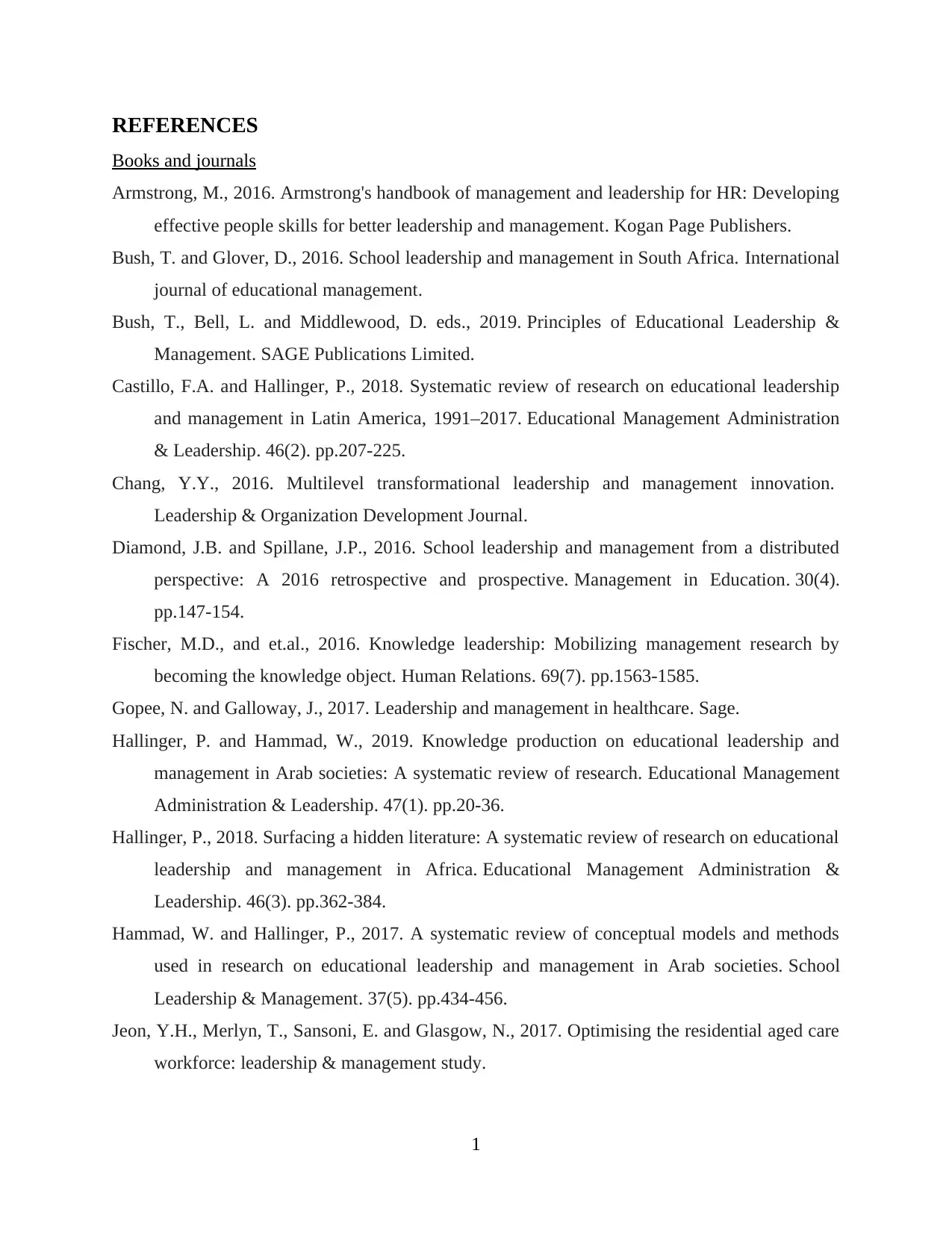
REFERENCES
Books and journals
Armstrong, M., 2016. Armstrong's handbook of management and leadership for HR: Developing
effective people skills for better leadership and management. Kogan Page Publishers.
Bush, T. and Glover, D., 2016. School leadership and management in South Africa. International
journal of educational management.
Bush, T., Bell, L. and Middlewood, D. eds., 2019. Principles of Educational Leadership &
Management. SAGE Publications Limited.
Castillo, F.A. and Hallinger, P., 2018. Systematic review of research on educational leadership
and management in Latin America, 1991–2017. Educational Management Administration
& Leadership. 46(2). pp.207-225.
Chang, Y.Y., 2016. Multilevel transformational leadership and management innovation.
Leadership & Organization Development Journal.
Diamond, J.B. and Spillane, J.P., 2016. School leadership and management from a distributed
perspective: A 2016 retrospective and prospective. Management in Education. 30(4).
pp.147-154.
Fischer, M.D., and et.al., 2016. Knowledge leadership: Mobilizing management research by
becoming the knowledge object. Human Relations. 69(7). pp.1563-1585.
Gopee, N. and Galloway, J., 2017. Leadership and management in healthcare. Sage.
Hallinger, P. and Hammad, W., 2019. Knowledge production on educational leadership and
management in Arab societies: A systematic review of research. Educational Management
Administration & Leadership. 47(1). pp.20-36.
Hallinger, P., 2018. Surfacing a hidden literature: A systematic review of research on educational
leadership and management in Africa. Educational Management Administration &
Leadership. 46(3). pp.362-384.
Hammad, W. and Hallinger, P., 2017. A systematic review of conceptual models and methods
used in research on educational leadership and management in Arab societies. School
Leadership & Management. 37(5). pp.434-456.
Jeon, Y.H., Merlyn, T., Sansoni, E. and Glasgow, N., 2017. Optimising the residential aged care
workforce: leadership & management study.
1
Books and journals
Armstrong, M., 2016. Armstrong's handbook of management and leadership for HR: Developing
effective people skills for better leadership and management. Kogan Page Publishers.
Bush, T. and Glover, D., 2016. School leadership and management in South Africa. International
journal of educational management.
Bush, T., Bell, L. and Middlewood, D. eds., 2019. Principles of Educational Leadership &
Management. SAGE Publications Limited.
Castillo, F.A. and Hallinger, P., 2018. Systematic review of research on educational leadership
and management in Latin America, 1991–2017. Educational Management Administration
& Leadership. 46(2). pp.207-225.
Chang, Y.Y., 2016. Multilevel transformational leadership and management innovation.
Leadership & Organization Development Journal.
Diamond, J.B. and Spillane, J.P., 2016. School leadership and management from a distributed
perspective: A 2016 retrospective and prospective. Management in Education. 30(4).
pp.147-154.
Fischer, M.D., and et.al., 2016. Knowledge leadership: Mobilizing management research by
becoming the knowledge object. Human Relations. 69(7). pp.1563-1585.
Gopee, N. and Galloway, J., 2017. Leadership and management in healthcare. Sage.
Hallinger, P. and Hammad, W., 2019. Knowledge production on educational leadership and
management in Arab societies: A systematic review of research. Educational Management
Administration & Leadership. 47(1). pp.20-36.
Hallinger, P., 2018. Surfacing a hidden literature: A systematic review of research on educational
leadership and management in Africa. Educational Management Administration &
Leadership. 46(3). pp.362-384.
Hammad, W. and Hallinger, P., 2017. A systematic review of conceptual models and methods
used in research on educational leadership and management in Arab societies. School
Leadership & Management. 37(5). pp.434-456.
Jeon, Y.H., Merlyn, T., Sansoni, E. and Glasgow, N., 2017. Optimising the residential aged care
workforce: leadership & management study.
1
Secure Best Marks with AI Grader
Need help grading? Try our AI Grader for instant feedback on your assignments.
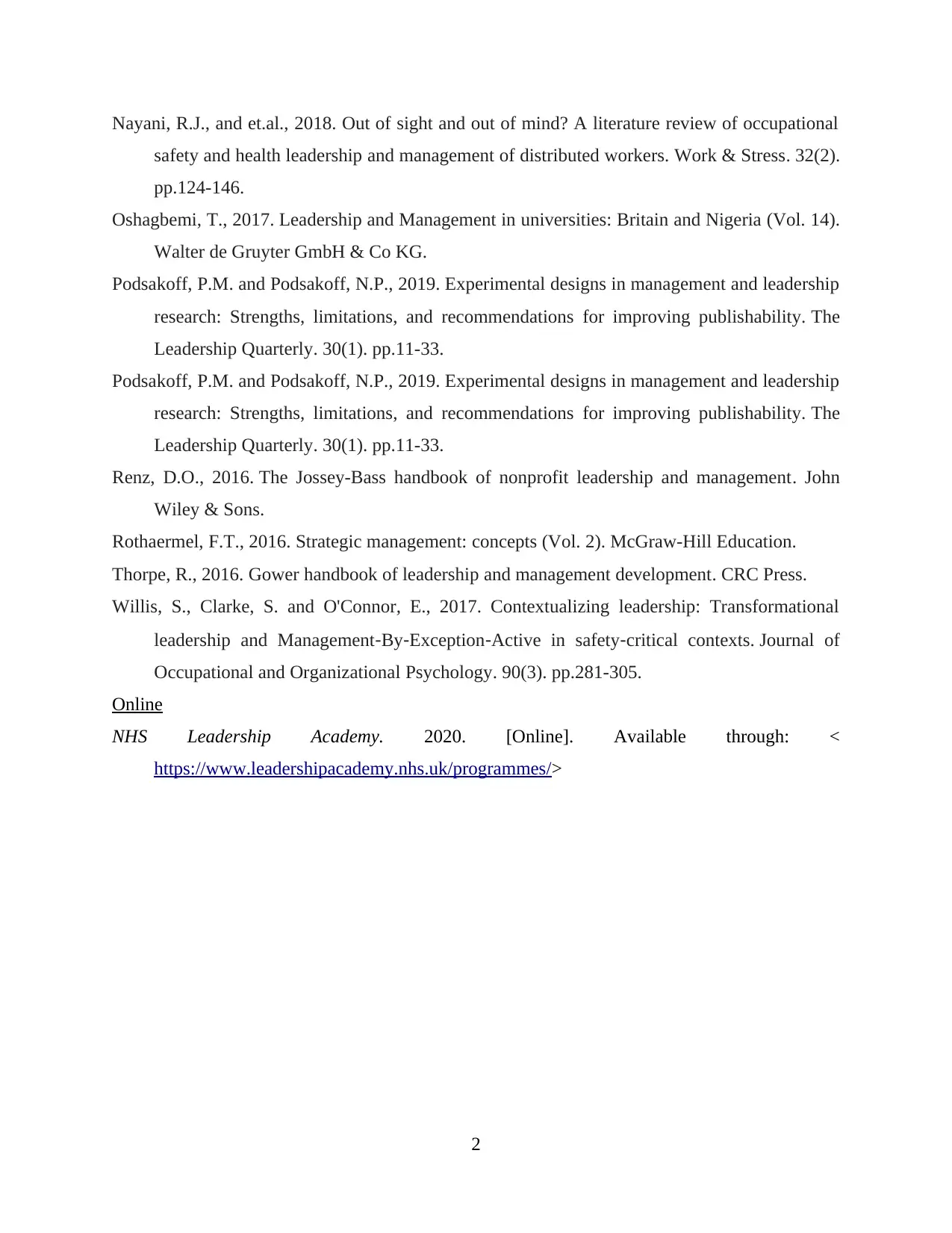
Nayani, R.J., and et.al., 2018. Out of sight and out of mind? A literature review of occupational
safety and health leadership and management of distributed workers. Work & Stress. 32(2).
pp.124-146.
Oshagbemi, T., 2017. Leadership and Management in universities: Britain and Nigeria (Vol. 14).
Walter de Gruyter GmbH & Co KG.
Podsakoff, P.M. and Podsakoff, N.P., 2019. Experimental designs in management and leadership
research: Strengths, limitations, and recommendations for improving publishability. The
Leadership Quarterly. 30(1). pp.11-33.
Podsakoff, P.M. and Podsakoff, N.P., 2019. Experimental designs in management and leadership
research: Strengths, limitations, and recommendations for improving publishability. The
Leadership Quarterly. 30(1). pp.11-33.
Renz, D.O., 2016. The Jossey-Bass handbook of nonprofit leadership and management. John
Wiley & Sons.
Rothaermel, F.T., 2016. Strategic management: concepts (Vol. 2). McGraw-Hill Education.
Thorpe, R., 2016. Gower handbook of leadership and management development. CRC Press.
Willis, S., Clarke, S. and O'Connor, E., 2017. Contextualizing leadership: Transformational
leadership and Management‐By‐Exception‐Active in safety‐critical contexts. Journal of
Occupational and Organizational Psychology. 90(3). pp.281-305.
Online
NHS Leadership Academy. 2020. [Online]. Available through: <
https://www.leadershipacademy.nhs.uk/programmes/>
2
safety and health leadership and management of distributed workers. Work & Stress. 32(2).
pp.124-146.
Oshagbemi, T., 2017. Leadership and Management in universities: Britain and Nigeria (Vol. 14).
Walter de Gruyter GmbH & Co KG.
Podsakoff, P.M. and Podsakoff, N.P., 2019. Experimental designs in management and leadership
research: Strengths, limitations, and recommendations for improving publishability. The
Leadership Quarterly. 30(1). pp.11-33.
Podsakoff, P.M. and Podsakoff, N.P., 2019. Experimental designs in management and leadership
research: Strengths, limitations, and recommendations for improving publishability. The
Leadership Quarterly. 30(1). pp.11-33.
Renz, D.O., 2016. The Jossey-Bass handbook of nonprofit leadership and management. John
Wiley & Sons.
Rothaermel, F.T., 2016. Strategic management: concepts (Vol. 2). McGraw-Hill Education.
Thorpe, R., 2016. Gower handbook of leadership and management development. CRC Press.
Willis, S., Clarke, S. and O'Connor, E., 2017. Contextualizing leadership: Transformational
leadership and Management‐By‐Exception‐Active in safety‐critical contexts. Journal of
Occupational and Organizational Psychology. 90(3). pp.281-305.
Online
NHS Leadership Academy. 2020. [Online]. Available through: <
https://www.leadershipacademy.nhs.uk/programmes/>
2

3
1 out of 15
![[object Object]](/_next/static/media/star-bottom.7253800d.svg)




